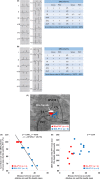Radiofrequency catheter ablation of premature ventricular contractions from near the His-bundle
- PMID: 31007790
- PMCID: PMC6457375
- DOI: 10.1002/joa3.12167
Radiofrequency catheter ablation of premature ventricular contractions from near the His-bundle
Abstract
Objective: This study aimed to investigate the effects of radiofrequency catheter ablation (RFCA) and clinical and electrophysiological characteristics in symptomatic patients with premature ventricular contractions (PVCs) from near the His-bundle (His-PVCs).
Methods: The patient characteristics, prevalence of complications with any life style related disease (ALSRD) including hypertension, dyslipidemia, or diabetes mellitus, and/or cardiovascular disease (CVD) including coronary artery disease, cerebrovascular disease, renal dysfunction, or cardiomyopathy, clinical status, frequency of PVCs evaluated by 24hour Holter monitoring, echocardiography including the left ventricular diastolic dysfunction (LVDD) parameters, and electrophysiological findings were evaluated in 14 consecutive symptomatic patients with His-PVCs.
Results: The prevalence of males, being elderly and/or slightly obese, current and/or history of smoking, ALSRD or CVD related complications, and LVDD probably resulting from ALSRD and/or CVD complications were higher in patients with His-PVCs. RFCA of His-PVCs steadily decreased the PVC frequency and improved the systolic function, LV dilation, and clinical status, but not the LVDD. There was a significant relationship between the accordance rate of the QRS polarity between sinus rhythm and His-PVCs and the distance between the successful ablation site and His-bundle.
Conclusion: The analysis of the QRS duration and accordance rate of the QRS polarity between sinus rhythm and His-PVCs before the RFCA may help to determine the distance between the origin of the PVCs and His-bundle. Further, the appropriate ablation catheter may be selected during the RFCA procedure. Finally, RFCA may be one of the most effective, feasible, and safest therapies for symptomatic patients with His-PVCs.
Keywords: His‐bundle; catheter ablation; clinical characteristics; clinical status; premature ventricular contraction.
Conflict of interest statement
Authors declare no conflict of interests for this article.
Figures

Similar articles
-
Radiofrequency catheter ablation of premature ventricular contractions from the mitral annulus in patients without structural heart disease.Pacing Clin Electrophysiol. 2020 Nov;43(11):1258-1267. doi: 10.1111/pace.14063. Epub 2020 Sep 30. Pacing Clin Electrophysiol. 2020. PMID: 32901968 Free PMC article.
-
Clinical, electrocardiographic and electrophysiological characteristics, and catheter ablation results of left upper septal premature ventricular complexes.J Cardiovasc Electrophysiol. 2020 Dec;31(12):3251-3261. doi: 10.1111/jce.14765. Epub 2020 Oct 11. J Cardiovasc Electrophysiol. 2020. PMID: 33010075
-
Where is the exact origin of narrow premature ventricular contractions manifesting qR in inferior wall leads?BMC Cardiovasc Disord. 2016 Apr 4;16:64. doi: 10.1186/s12872-016-0240-4. BMC Cardiovasc Disord. 2016. PMID: 27044385 Free PMC article.
-
Cardiomyopathy induced by premature ventricular contractions with ventricular escape beats in the compensatory pause: A case report and brief review of the literature.Medicine (Baltimore). 2022 Aug 26;101(34):e30277. doi: 10.1097/MD.0000000000030277. Medicine (Baltimore). 2022. PMID: 36042677 Free PMC article. Review.
-
Predictors of Left Ventricular Ejection Fraction Improvement after Radiofrequency Catheter Ablation in Patients with PVC-Induced Cardiomyopathy: A Systematic Review.Curr Cardiol Rev. 2020;16(4):315-325. doi: 10.2174/1573403X15666190710095248. Curr Cardiol Rev. 2020. PMID: 31288727 Free PMC article.
Cited by
-
Radiofrequency catheter ablation of premature ventricular contractions from the mitral annulus in patients without structural heart disease.Pacing Clin Electrophysiol. 2020 Nov;43(11):1258-1267. doi: 10.1111/pace.14063. Epub 2020 Sep 30. Pacing Clin Electrophysiol. 2020. PMID: 32901968 Free PMC article.
-
Premature ventricular contractions with acute successful radiofrequency catheter ablation near the atrioventricular node using reversed C curve technique.BMC Cardiovasc Disord. 2022 Aug 31;22(1):390. doi: 10.1186/s12872-022-02832-1. BMC Cardiovasc Disord. 2022. PMID: 36045329 Free PMC article.
-
Radiation dose to the eye of physicians during radio frequency catheter ablation: a small-scale study.Ir J Med Sci. 2024 Dec;193(6):2745-2751. doi: 10.1007/s11845-024-03802-6. Epub 2024 Oct 5. Ir J Med Sci. 2024. PMID: 39367959 Free PMC article. Review.
-
Impact of Pulsed Electric Field Ablation on His Bundle Conduction: A Preclinical Canine Study.Med Sci Monit. 2024 Jul 30;30:e945007. doi: 10.12659/MSM.945007. Med Sci Monit. 2024. PMID: 39078809 Free PMC article.
-
Usefulness of the synthesized 18-lead ECG in premature ventricular contractions from near the HIS bundle.J Arrhythm. 2023 Feb 20;39(2):231-234. doi: 10.1002/joa3.12834. eCollection 2023 Apr. J Arrhythm. 2023. PMID: 37021032 Free PMC article. No abstract available.
References
-
- Takemoto M, Yoshimura H, Ohba Y, et al. Radiofrequency catheter ablation of premature ventricular complexes from right ventricular outflow tract improves left ventricular dilation and clinical status in patients without structural heart disease. J Am Coll Cardiol. 2005;45:1259–65. - PubMed
-
- Akhtar M, Breithardt G, Camm AJ, et al. Implications of the Cardiac Arrhythmia Suppression Trial. Task Force of the Working Group on Arrhythmias of the European Society of Cardiology. Circulation. 1990;81:1123–27. - PubMed
-
- Yamauchi Y, Aonuma K, Takahashi A, et al. Electrocardiographic characteristics of repetitive monomorphic right ventricular tachycardia originating near the His‐bundle. J Cardiovasc Electrophysiol. 2005;16:1041–48. - PubMed
-
- Hachiya H, Hirao K, Sasaki T, et al. Novel ECG predictor of difficult cases of outflow tract ventricular tachycardia: peak deflection index on an inferior lead. Circ J. 2010;74:256–61. - PubMed
LinkOut - more resources
Full Text Sources

